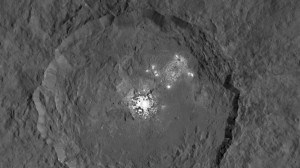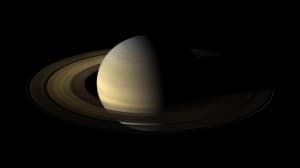
 The bright spots on dwarf planet Ceres gleam with mystery in new views delivered by NASA’s Dawn spacecraft from an altitude of 950 miles. These closest-yet views of Occator crater, with a resolution of 450 feet per pixel, give a deeper perspective on these very unusual features.
The bright spots on dwarf planet Ceres gleam with mystery in new views delivered by NASA’s Dawn spacecraft from an altitude of 950 miles. These closest-yet views of Occator crater, with a resolution of 450 feet per pixel, give a deeper perspective on these very unusual features.
Animations are available at:
www.jpl.nasa.gov/spaceimages/details.php?id=pia19890
www.jpl.nasa.gov/spaceimages/details.php?id=pia19891
Dawn is the first mission to visit a dwarf planet, and the first to orbit two distinct solar system targets. It orbited protoplanet Vesta for 14 months in 2011 and 2012, and arrived at Ceres on March 6, 2015.
*******
ONE OF SATURN’S RINGS IS NOT LIKE THE OTHERS. When the sun set on Saturn’s rings in August 2009, scientists on NASA’s Cassini mission were watching closely. It was the equinox—one of two times in the Saturnian year when the sun illuminates the planet’s enormous ring system edge-on.
Like Earth, Saturn is tilted on its axis. Over the course of its 29-year-long orbit, the sun’s rays move from north to south over the planet and its rings, and back again. The changing sunlight causes the temperature of the rings—which are made of trillions of icy particles—to vary from season to season. During equinox, which lasted only a few days, unusual shadows and wavy structures appeared and, as they sat in twilight for this brief period, the rings began to cool.
move from north to south over the planet and its rings, and back again. The changing sunlight causes the temperature of the rings—which are made of trillions of icy particles—to vary from season to season. During equinox, which lasted only a few days, unusual shadows and wavy structures appeared and, as they sat in twilight for this brief period, the rings began to cool.
In a recent study published in the journal Icarus, a team of Cassini scientists reported that one section of the rings appears to have remained warmer than expected during equinox. This provided a unique window into the interior structure of ring particles not usually available to scientists.
“For the most part, we can’t learn much about what Saturn’s ring particles are like deeper than 1 millimeter below the surface. But the fact that one part of the rings didn’t cool as expected allowed us to model what they might be like on the inside,” said Ryuji Morishima of JPL, who led the study.
The researchers examined data collected by Cassini’s Composite Infrared Spectrometer during the year around equinox. The instrument essentially took the rings’ temperature as they cooled. The scientists then compared the temperature data with computer models that attempt to describe the properties of ring particles on an individual scale.
What they found was puzzling. For most of the giant expanse of Saturn’s rings, the models correctly predicted how the rings cooled as they fell into darkness. But one large section—the outermost of the large, main rings, called the A ring—was much warmer than the models predicted.
To address this curiosity, Morishima and colleagues performed a detailed investigation of how ring particles with different structures would warm up and cool down during Saturn’s seasons. The team’s analysis suggested the best explanation for the A ring’s equinox temperatures was for the ring to be composed largely of particles roughly 3 feet wide made of mostly solid ice.
“A high concentration of dense, solid ice chunks in this one region of Saturn’s rings is unexpected,” said Morishima. “Ring particles usually spread out and become evenly distributed on a timescale of about 100 million years.”


Be the first to comment